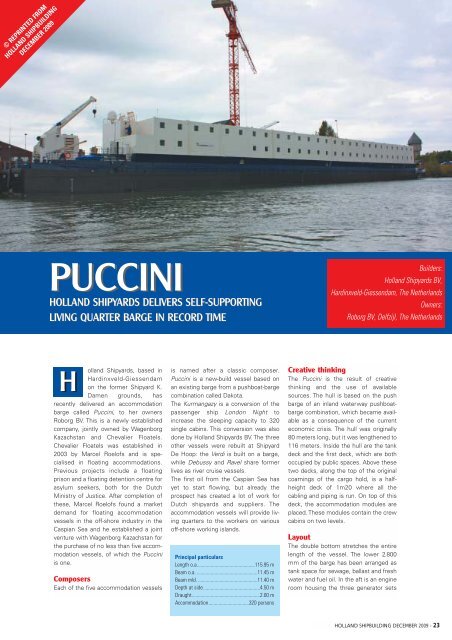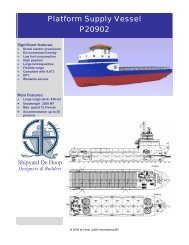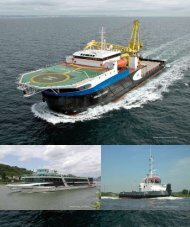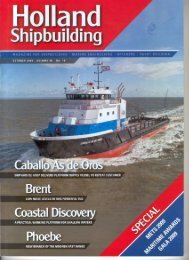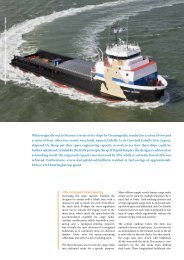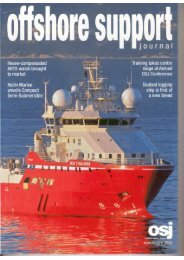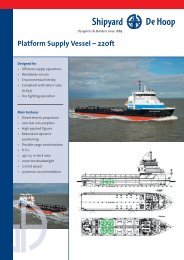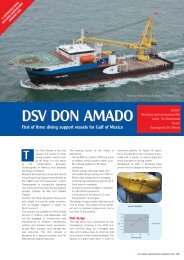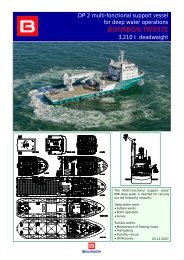2009 December Holland Shipbuilding Wagenborg Puccini - De Hoop
2009 December Holland Shipbuilding Wagenborg Puccini - De Hoop
2009 December Holland Shipbuilding Wagenborg Puccini - De Hoop
You also want an ePaper? Increase the reach of your titles
YUMPU automatically turns print PDFs into web optimized ePapers that Google loves.
© REPRINTED FROM<br />
HOLLAND SHIPBUILDING<br />
DECEMBER <strong>2009</strong><br />
PUCCINI<br />
HOLLAND SHIPYARDS DELIVERS SELF-SUPPORTING<br />
LIVING QUARTER BARGE IN RECORD TIME<br />
Builders:<br />
<strong>Holland</strong> Shipyards BV,<br />
Hardinxveld-Giessendam, The Netherlands<br />
Owners:<br />
Roborg BV, <strong>De</strong>lfzijl, The Netherlands<br />
H<br />
olland Shipyards, based in<br />
Hardinxveld-Giessendam<br />
on the former Shipyard K.<br />
Damen grounds, has<br />
recently delivered an accommodation<br />
barge called <strong>Puccini</strong>, to her owners<br />
Roborg BV. This is a newly established<br />
company, jointly owned by <strong>Wagenborg</strong><br />
Kazachstan and Chevalier Floatels.<br />
Chevalier Floatels was established in<br />
2003 by Marcel Roelofs and is specialised<br />
in floating accommodations.<br />
Previous projects include a floating<br />
prison and a floating detention centre for<br />
asylum seekers, both for the Dutch<br />
Ministry of Justice. After completion of<br />
these, Marcel Roelofs found a market<br />
demand for floating accommodation<br />
vessels in the off-shore industry in the<br />
Caspian Sea and he established a joint<br />
venture with <strong>Wagenborg</strong> Kazachstan for<br />
the purchase of no less than five accommodation<br />
vessels, of which the <strong>Puccini</strong><br />
is one.<br />
Composers<br />
Each of the five accommodation vessels<br />
is named after a classic composer.<br />
<strong>Puccini</strong> is a new-build vessel based on<br />
an existing barge from a pushboat-barge<br />
combination called Dakota.<br />
The Kurmangazy is a conversion of the<br />
passenger ship London Night to<br />
increase the sleeping capacity to 320<br />
single cabins. This conversion was also<br />
done by <strong>Holland</strong> Shipyards BV. The three<br />
other vessels were rebuilt at Shipyard<br />
<strong>De</strong> <strong>Hoop</strong>: the Verdi is built on a barge,<br />
while <strong>De</strong>bussy and Ravel share former<br />
lives as river cruise vessels.<br />
The first oil from the Caspian Sea has<br />
yet to start flowing, but already the<br />
prospect has created a lot of work for<br />
Dutch shipyards and suppliers. The<br />
accommodation vessels will provide living<br />
quarters to the workers on various<br />
off-shore working islands.<br />
Principal particulars<br />
Length o.a..............................................115.95 m<br />
Beam o.a. ................................................11.45 m<br />
Beam mld. ...............................................11.40 m<br />
<strong>De</strong>pth at side.............................................4.50 m<br />
Draught......................................................2.00 m<br />
Accommodation................................320 persons<br />
Creative thinking<br />
The <strong>Puccini</strong> is the result of creative<br />
thinking and the use of available<br />
sources. The hull is based on the push<br />
barge of an inland waterway pushboatbarge<br />
combination, which became available<br />
as a consequence of the current<br />
economic crisis. The hull was originally<br />
80 meters long, but it was lengthened to<br />
116 meters. Inside the hull are the tank<br />
deck and the first deck, which are both<br />
occupied by public spaces. Above these<br />
two decks, along the top of the original<br />
coamings of the cargo hold, is a halfheight<br />
deck of 1m20 where all the<br />
cabling and piping is run. On top of this<br />
deck, the accommodation modules are<br />
placed. These modules contain the crew<br />
cabins on two levels.<br />
Layout<br />
The double bottom stretches the entire<br />
length of the vessel. The lower 2.800<br />
mm of the barge has been arranged as<br />
tank space for sewage, ballast and fresh<br />
water and fuel oil. In the aft is an engine<br />
room housing the three generator sets<br />
HOLLAND SHIPBUILDING DECEMBER <strong>2009</strong> - 23
The buffet is located in a corner of the dining room<br />
Each cabin sleeps 4 in two bunk beds<br />
and the boilers. Just forward of the midship<br />
is another technical space with the<br />
watermakers, the UV water treatment<br />
and the sewage treatment plant. Above<br />
this tank deck is the lower deck, which<br />
houses from aft to fore:<br />
– engine room;<br />
– cold stores;<br />
– galley and scullery;<br />
– messroom with buffet corner;<br />
– sanitary facilities;<br />
– the stairwell covering all decks;<br />
– a day room with 50 seats;<br />
– a meeting room;<br />
– linen stores and laundry;<br />
– a gymnasium.<br />
Between the lower deck and the main<br />
deck is the 1m20 “tech deck” which<br />
has enabled the fast construction time<br />
and usage of removable accommodation<br />
modules on deck.<br />
Superstructure<br />
Above the engine room is a small open<br />
aft deck with a funnel, a crane and a<br />
staircase. For easy provisioning, a 10-<br />
foot container can be lowered with the<br />
crane into a large deck hatch. The crane<br />
from HS Marine type AFB170/10 can lift<br />
10 tons at its maximum reach of 10<br />
meters. It was supplied by Promac. The<br />
10-foot container is immediately placed<br />
in a lobby right next to the provision<br />
stores, so the handling of supplies can<br />
entirely be done inside. The access from<br />
the main aft deck to the accommodation<br />
leads to the reception with three offices,<br />
a shower room and public toilets and a<br />
large changing room with 280 lockers. In<br />
the changing room, PronovaCT has<br />
installed drying equipment for 280 pairs<br />
of boots and for 30 jackets. This gives a<br />
longer lifetime to the equipment and the<br />
crew benefits from dry clothes at the<br />
beginning of their shift, resulting in a<br />
better atmosphere and less sick leave.<br />
The rest of the main deck is taken up by<br />
forty 4-person cabins and a treatment<br />
room with three beds and a separate<br />
quarantine area.<br />
The upper deck features a large lounge<br />
aft with 104 seats, consisting of four<br />
lounge corners, 13 four-person games<br />
tables and two larger tables to seat six<br />
persons. Another forty 4-person cabins,<br />
each with an individual bathroom, and an<br />
internet café with 16 workstations complete<br />
the upper deck.<br />
Limited time<br />
The build and transfer of the <strong>Puccini</strong> was<br />
no small feat. Time was limited, as the<br />
Caspian sea can be frozen by mid-<br />
November and the vessels had to be in<br />
place before that. The contract for the<br />
vessels was signed on 10 June <strong>2009</strong>. The<br />
workers of <strong>Holland</strong> Shipyards managed<br />
to complete both vessels on time in a<br />
mere 17 weeks. The <strong>Puccini</strong> and<br />
Kurmangazy were delivered on 6 and 8<br />
October <strong>2009</strong>. Because of the transfer<br />
route by the river Donau with its low<br />
bridges, the accommodation units of the<br />
<strong>Puccini</strong> were designed and built in such a<br />
way that they could easily be taken off<br />
and placed back onboard. Right after the<br />
delivery, the accommodation units were<br />
lifted off and shipped to Constanta in<br />
Romania on barges, where they were reinstalled<br />
in just four days. The arrangement<br />
with the intermediate service deck<br />
for piping and cabling made this possible.<br />
Zero-discharge area<br />
The Caspian Sea is the largest enclosed<br />
body of water in the world by area.<br />
Either classed as the world’s largest lake<br />
or as a sea, the Caspian Sea has no effluents.<br />
This means that water is only leaving<br />
the Caspian Sea by evaporation or by<br />
human activity. The salinity is about one<br />
third of that of most seawater and the<br />
water level is about 28 metres below<br />
sea level. Because of environmental reasons,<br />
the Caspian Sea is a zero-discharge<br />
area. The region’s oil reserves are<br />
estimated at more than 200 billion barrels,<br />
second in the world only to the<br />
Middle East.<br />
Self-supporting<br />
While not self-propelled, the <strong>Puccini</strong> is<br />
Three Veth gensets provide onboard power<br />
Hatenboer Water supplied 5 <strong>De</strong>mitec water makers<br />
24 - HOLLAND SHIPBUILDING DECEMBER <strong>2009</strong>
The 1.2 m high technical space above the main deck proved essential in<br />
achieving the speedy delivery<br />
The aft deck crane can lower a 10-foot container right into the<br />
provisioning store.<br />
fully self-supporting and can go without<br />
supplies for fourteen days. Three 500<br />
kW generator sets were supplied by<br />
Veth.<br />
The pumps onboard are Spanish Azcue<br />
pumps, supplied by Reikon. Given the<br />
extremely short delivery time, the<br />
watermaker capacity is achieved by 5<br />
smaller <strong>De</strong>mitec Sea Standard Reverse<br />
Osmosis units from Hatenboer Water.<br />
The sewage treatment system is a combined<br />
biological treatment unit type<br />
MSP VIII C S/S from Qua-vac with a<br />
capacity of 70 m3/day. The incinerator is<br />
a TeamTec type GC500CGSW.<br />
Harsh winter conditions<br />
The northern part of the Caspian Sea is<br />
known for its harsh winters where temperatures<br />
can drop below minus 40<br />
degrees, and the <strong>Puccini</strong> is built to deal<br />
with that. This means ample insulation<br />
and heating capacity inside. The HVAC<br />
installation was done by <strong>De</strong> Haan from<br />
Hoogezand, and is with fancoil units in<br />
the cabins. Ice class strengthening was<br />
investigated as an option, but it was<br />
deemed prohibitively costly, given that<br />
the vessel will always be used in sheltered<br />
waters, where ice class is not<br />
required.<br />
Market potential<br />
<strong>Holland</strong> Shipyards believes there is a<br />
growing market potential for living quarter<br />
barges. The yard, which was established<br />
in 2007 by Instalho and<br />
Concordia, is actively pursuing orders for<br />
accommodation vessels in the wake of<br />
the <strong>Puccini</strong> but is also ready to take on<br />
different projects. With <strong>Puccini</strong>, the yard<br />
has again demonstrated their ability to<br />
deliver quality, even when only a very<br />
limited amount of time is available.<br />
Subcontractors and suppliers of equipment<br />
fitted on board the ‘Pucinni’<br />
(partial list)<br />
Atlas Ship <strong>De</strong>livery, Hoofdorp . . . . . .: logistics<br />
ASD Shipdesign, Alblasserdam . . . . .: engineering<br />
Bakker Proffesionals, Berlicum . . . . .: galley inventory<br />
Concordia Shipyards, Werkendam . .: hull delivery<br />
Dyvler Materiaal,<br />
Hardinxveld-Giessendam . . . . . . . . . . . .: winch<br />
<strong>Holland</strong> Shipyards,<br />
Hardinxveld-Giessendam . . . . . . . . . . . .: completion and<br />
supervision<br />
Bureau Veritas, Rotterdam . . . . . . . . . : classification<br />
C-Job & Partners, Hoofddorp . . . . . . .: engineering<br />
Cornet Service , Werkendam . . . . . . .: conservation/wWorkdeck<br />
Droste Elektro, Tolkamer . . . . . . . . . . .: electrical installation<br />
Haan v/h Gebr., <strong>De</strong>, Hoogezand . . . . .: HVAC<br />
Hatenboer-Water, Schiedam . . . . . . .: watermakers<br />
Hoogendoorns Maritieme<br />
betimmeringen en Interieurbouw,<br />
Werkendam . . . . . . . . . . . . . . . . . . . . . . .: interior carpeting<br />
Miele Nederland, Vianen . . . . . . . . . .: laundry equipment<br />
Promac, Zaltbommel . . . . . . . . . . . . . . .: HS Marine Crane<br />
Qua-Vac, Almere . . . . . . . . . . . . . . . . . .: sewage plant<br />
Reikon , Spijkenisse . . . . . . . . . . . . . . . .: pumps<br />
Stout Technisch Installatie Bureau,<br />
Hardinxveld-Giessendam . . . . . . . . . . . .: sanitary systems<br />
Stout Pijpleidingen,<br />
Hardinxveld-Giessendam . . . . . . . . . . . .: piping<br />
Team Tech, Gjeving , Norway, . . . . . . .: incinerator<br />
Trinoxx, Hardinxveld-Giessendam . . . .: hatches, ceilings, walls,<br />
windows and doors<br />
Veth Propulsion, Papendrecht . . . . . . .: generator sets<br />
The aft deck crane can lower a 10-foot container right into the provisioning store<br />
HOLLAND SHIPBUILDING DECEMBER <strong>2009</strong> - 25
GENERAL ARRANGEMENT<br />
• Turn Key <strong>De</strong>livery<br />
• Total Electric Installation<br />
• Diesel- Electric Propulsion<br />
<strong>De</strong> Krib 3 • 6916 AN TOLKAMER • The Netherlands<br />
www.droste-elektro.nl • Phone +31 (0)316 541 759<br />
26 - HOLLAND SHIPBUILDING DECEMBER <strong>2009</strong>


